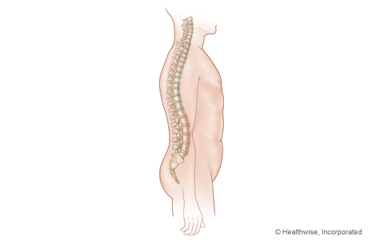Kyphosis: Care Instructions
Overview

Kyphosis is a rounding of the spine. It can make you look like you have a hump in your back.
Some people are born with the problem. Other people have an injury, infection, or disease that causes it.
Young teens can get a type of kyphosis called Scheuermann's disease. And older people can get a rounded back
because of spine fractures caused by osteoporosis.
Kyphosis may or may not make your back hurt. In bad cases, it makes it hard to breathe.
Treatment for kyphosis depends on what caused it. Some young teens may wear a brace. The spine will
straighten as they grow. Sometimes exercises and medicine may help pain. In other cases, surgery is needed.
A rounded spine can be stressful, especially for teens. They may be embarrassed about how they look. Give
your child lots of love and support. And if your child needs more help, you may want to think about
counseling.
Follow-up care is a key part of your treatment and safety. Be sure to make and go to all
appointments, and call your doctor if you are having problems. It's also a good idea to know your test results
and keep a list of the medicines you take.
How can you care for yourself at home?
-
Be safe with medicines. Read and follow all instructions on the label.
-
If you have osteoporosis, follow your treatment. Take your medicines exactly as prescribed. Call your
doctor if you think you are having a problem with your medicine.
-
If your doctor recommends a back brace, follow their directions for wearing it.
-
Get at least 30 minutes of physical activity on most days of the week. Walking is a good choice. You also
may want to do other activities, such as swimming or cycling. Ask your doctor what type and how much
activity is good for you.
-
Go to physical therapy. A physical therapist can show you exercises to do at home. These can help with
pain and make your muscles stronger and your back more flexible.
When should you call for help?
 Call 911
anytime you think you may need emergency care. For example, call if:
Call 911
anytime you think you may need emergency care. For example, call if:
Call your doctor now or seek immediate medical care if:
|
|
-
You have new or worse symptoms in your arms, legs, chest, belly, or buttocks. Symptoms may
include:
-
Numbness or tingling.
-
Weakness.
-
Pain.
|
|
|
|
Watch closely for changes in your health, and be sure to contact your doctor if:
Current as of: July 17, 2023
Content Version: 14.0
Care instructions adapted under license by your
healthcare professional. If you have questions about a medical condition or this instruction, always ask
your healthcare professional. Healthwise, Incorporated disclaims any warranty or liability for your use of
this information.